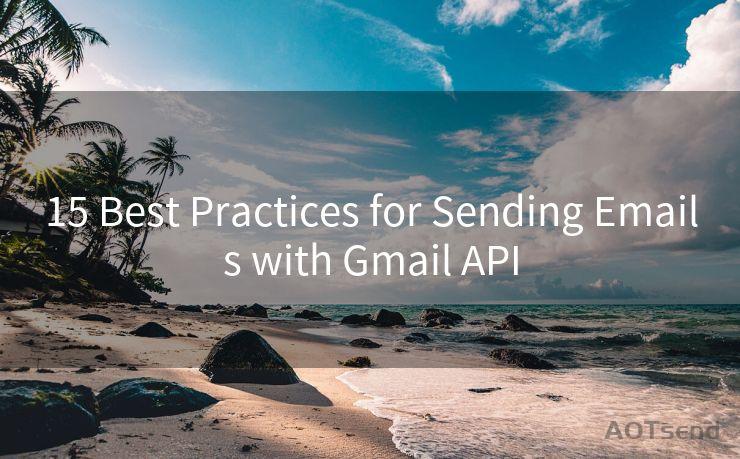15 Best Practices for Sending Emails with Gmail API




When it comes to sending emails programmatically, the Gmail API offers a robust and flexible solution. However, to make the most of this powerful tool, it's essential to follow best practices. In this article, we'll explore 15 key tips for sending emails with the Gmail API to ensure maximum efficiency and effectiveness.
1. Understand the Gmail API Basics
Before diving into the best practices, it's crucial to have a solid understanding of the Gmail API and its capabilities. Familiarize yourself with the various endpoints, authentication methods, and quotas to avoid any surprises later on.
2. Set Up OAuth 2.0 Authentication
Ensure secure and authorized access to user data by setting up OAuth 2.0 authentication. This process verifies the identity of the application requesting access to a user's Gmail account.
3. Manage API Quotas and Limits
Be mindful of the Gmail API's quotas and limits. Exceeding these limits can result in errors or even suspension of your API access. Monitor your usage closely and adjust your email sending strategy accordingly.

4. Optimize Your Email Content
Craft your email content with care. Use a clear and concise subject line, and ensure the body of the email is relevant and engaging. Avoid spammy language or excessive use of capitalization, exclamation marks, or promotional phrases.
5. Personalize Your Messages
Personalization is key in email marketing. Utilize the Gmail API's capabilities to insert personalized content, such as the recipient's name or other relevant data, to increase engagement and conversions.
6. Test Your Emails
Before sending out a mass email campaign, test your emails thoroughly. Send test emails to yourself or colleagues to check for formatting issues, broken links, or any other potential problems.
7. Handle Bounces and Errors Gracefully
Prepare for email bounces and errors by implementing appropriate error handling mechanisms. Monitor the response codes from the Gmail API and take appropriate action, such as removing invalid email addresses from your list or retrying failed deliveries.
8. Use Batch Processing for Efficiency
When sending emails to multiple recipients, utilize the Gmail API's batch processing feature. This allows you to send multiple emails with a single API request, significantly improving efficiency and reducing the number of API calls.
9. Comply with Anti-Spam Policies
Ensure that your email campaigns comply with anti-spam policies, such as the CAN-SPAM Act. Include a clear and conspicuous unsubscribe option, and honor unsubscribe requests promptly.
10. Monitor and Analyze Performance
Track and analyze the performance of your email campaigns using metrics like open rates, click-through rates, and conversions. Use this data to refine your email strategy and improve future campaigns.
11. Secure Your API Keys and Credentials
Protect your API keys and credentials by storing them securely. Avoid hardcoding them into your application and consider using environment variables or a secure credential storage solution.
12. Optimize for Mobile Devices
Ensure that your emails are optimized for mobile devices. Use responsive design techniques to ensure readability and usability on smaller screens.
🔔🔔🔔
【AOTsend Email API】:AOTsend is a Managed Email Service for sending transactional emails. Support Email Types: reminders, authentication, confirmations, notifications, verification codes, invoices, password resets, account activations, billing statements, two-factor authentication (2FA), and one-time passwords (OTP) emails, etc. $0.28 per 1000 Emails. 99% Delivery, 98% Inbox Rate.
You might be interested in:
Why did we start the AOTsend project, Brand Story?
What is a Managed Email API, How it Works?
Best 25+ Email Marketing Platforms (Authority,Keywords&Traffic Comparison)
Best 24+ Email Marketing Service (Price, Pros&Cons Comparison)
Email APIs vs SMTP: How they Works, Any Difference?
13. Follow Email Best Practices
Adhere to general email best practices, such as using a clear call to action, providing valuable content, and maintaining a consistent brand voice and tone.
14. Handle Unsubscribe Requests
Respect the wishes of recipients who unsubscribe from your email list. Implement a robust unsubscribe process that removes them from future campaigns immediately.
15. Stay Up to Date with Gmail API Updates
Keep yourself informed about any updates or changes to the Gmail API. Subscribe to relevant blogs, forums, or newsletters to stay on top of the latest developments and best practices.
By following these 15 best practices for sending emails with the Gmail API, you can ensure that your email campaigns are effective, efficient, and compliant. Remember to always test, analyze, and adapt your strategy based on the data you collect to continuously improve your email marketing efforts.




Scan the QR code to access on your mobile device.
Copyright notice: This article is published by AotSend. Reproduction requires attribution.
Article Link:https://www.mailwot.com/p2570.html



